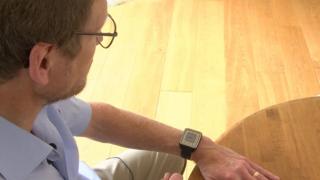Parkinson’s disease: ‘Smartwatch’ tracker monitors patients at home

A smartwatch-style device that tracks patient’s movements has been hailed as “the future of Parkinson’s care.”
The personal Kinetigraph (PKG) monitors tremors and other symptoms, potentially enabling doctors to spot problems remotely.
Patients with the degenerative condition are supposed to get half-yearly check-ups but delays are common.
Researchers believe the watch could help to ease pressure on over-stretched health services.
Plymouth University has enlisted 150 patients across the South West for a trial of the device.
How does it work?
Patients wear the PKG over a six-day period before sending it away for data to be analysed.
The device records motor symptoms including tremors, involuntary movements (dyskinesia) and slowness of movement (bradykinesia).
It also reminds wearers to take medication, asking them to swipe across to confirm they have done so.
As well as tracking movements, researchers say the PKG also enables medics to assess the impact of medication on the frequency and severity of symptoms.
Patients in the trial also fill out questionnaires detailing non-motor symptoms such as changes in mood.
Taken together, the information allows clinicians to assess whether changes need to be made to a patient’s drugs or other care.
Delays ‘a huge worry’
John Whipps, 66, was forced to retire as a professor in plant pathology and microbiology when he was diagnosed with Parkinson’s 12 years ago.
He said he “sort of fell apart” and “lost all the will to do almost anything”.
Mr Whipps from Looe, Cornwall, said he has waited up to 18 months for a consultant appointment and that delays were a “huge worry” for those with a progressive condition.
He said the PKG was “very easy to use” and meant patients should “get the response back very quickly”.
“It takes the pressure off the professionals so they don’t have to see patients so often,” he said.
He believes the watch could also be beneficial for healthcare providers.
“It must save the country a very large sum of money,” he said.
How will it help patients?
In 2018 it was estimated 145,000 people in the UK were living with Parkinson’s Disease – a figure predicted to increase by a fifth by 2025,
Current guidelines suggest patients with Parkinson’s Disease should receive specialist review at least every six months, but researchers said appointments were often delayed.
Steve Ford, chief executive of Parkinson’s UK, said gaps between hospital visits meant it could be hard for patients to accurately describe changes in their symptoms.
Lead researcher Dr Camille Carroll said one of the main aims of the watch project was to find a way to reduce pressure on over-stretched specialist services.
“The resources we have within the health service are pretty much remaining static if not falling,” Dr Carroll said.
She said the watch could help hospitals “target care and support when it is needed and where it is needed”.
Mr Ford said the watch was “really exciting”.
“Having technology that really measures the real-life aspects of Parkinson’s is fantastic and I am sure this is going to be the future of Parkinson’s care,” he added.
Parkinson’s UK is part-funding the project alongside charity the Health Foundation.

